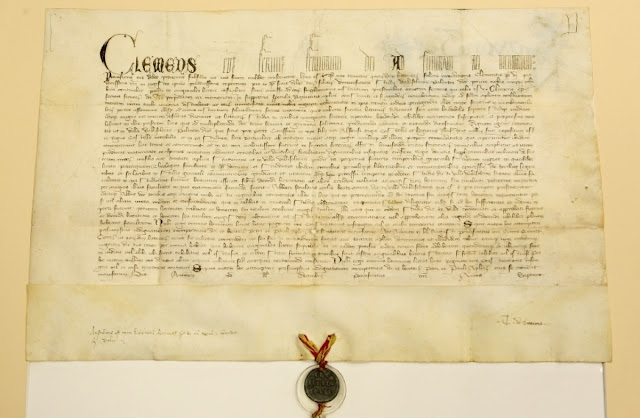07031528 Pope Clement VII approves Capuchin Reform
The CAPUCHINS are a branch or portion of the Order of Friars Minor founded by Saint Francis of Assisi, who, in the 16th century, seeking a stricter and more faithful experience of the Rule and original way of life, separated from the Observance. The official website of the Capuchin Order on the internet is at http://www.ofmcap.org/
ORIGIN OF THE CAPUCHIN ORDER
by Fr. Julio Micó, of.f.m.cap.
The unease produced by the feeling of infidelity to the original project of Francis of Assisi will accompany many, like a shadow, in the historical journey of the Fraternity, being the reason for the innumerable attempts at reform that Franciscanism has known through time.
In the middle of the 14th century, as a reaction against the "conventualism" of the Order, different groups of friars began to appear in Italy, Spain and France who aspired to a life more consistent with their Franciscan origins, wishing to return to a life more in keeping with their Franciscan origins. with the origins of the Fraternity, especially in retirement and poverty. Within this atmosphere of reform the Capuchins were born.
The reason was the same as always: a group of friars, in this case Mateo de Bascio, Pablo de Chioggia and the brothers Ludovico and Rafael de Fossombrone, dissatisfied with the life that was led in the "Observancia", decided to return to the hermitism of origins as a way of literally fulfilling the Rule.
Without prior permission from their Provincial, they chose to make their new way of life effective, which caused them endless persecutions and adventures until their friendship with Catalina Cibo, Duchess of Camerino and niece of the Pope, made it possible on July 3, 1528, by means of the bull Religionis zelus, Clement VII granted juridical existence to the new Fraternity. In reality, it was simply a matter of being able to lead an "eremitical life", keeping the Rule of Saint Francis, wearing a beard and a habit with a pyramidal hood - hence the name "Capuchins" - and preaching to the people.
The immediate influx of a large number of observers and some novices raised the need to make Constitutions that would define the incipient reform. A year later the first Chapter was convened to organize and draft the Constitutions which, because they were made in the hermitage of Albacina, have gone down in history as The Constitutions of Albacina, although in reality they bore the title of Constitutions of the called brothers of hermit life .
The Capuchin reform, so rigorous in its forms, was shown to be little Franciscan in the background. Reinforced by the entry of great personalities from the Observance, the need was seen to make it more balanced by returning to the genuine spirit of Francis. For this, a new Chapter was convoked in order to discuss the new Constitutions. Some of the initiators of the reform did not resist this change, creating real problems, so they had to be expelled from the Order. In 1536 the new Constitutions were promulgated, where moderation and balance between contemplation and action reached such a point that they practically became the definitive legislation of the Order. Subsequent renewals will only introduce details in a way that does not affect the content.
The celebration of the Council of Trent (1545-1563) favored the consolidation of the reform. With the establishment of study houses with a view to training for the ministry, more spacious convents and a more disciplined organization, the Capuchins not only established themselves but also managed to expand geographically.
First it was France, then Belgium. In Spain it was more difficult due to the existing prevention in the Court of Philip II, considering that the new reform of the Capuchins did not add anything to the already existing in Spain and very widespread reform of the Descalzos and Alcantarinos. The first attempt seems to have been in 1570, although without positive results. It was in 1578 when they managed to settle in Barcelona. The Order rapidly spread to Roussillon, then to Valencia (1596) and, finally, to Aragón (1598) and Navarra (1606). Castilla was still closed to the Capuchins, until in 1609 they managed to establish themselves in Madrid, subsequently multiplying by other points in Castilla and Andalusia (1613).
The Capuchins, therefore, in their decision to return to their origins, did nothing more than follow the atmosphere of renewal and give it concrete form. "Return to Francisco" was the slogan that beat at the bottom of the reform; then, as one of the first chroniclers says: «To reform is nothing other than to return to the original form given in the beginning to our Order».





Comments
Post a Comment